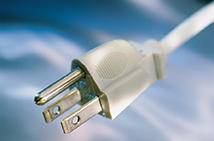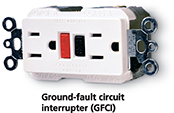| Effect of Current on Human Body | |
|---|---|
| Current Level | Effect |
| 1 mA | Slight tingling sensation |
| 5 mA | Slight shock |
| 6–30 mA | Painful shock; loss of muscular control |
| 50–150 mA | Extreme pain; severe muscular contractions. Breathing stops; death is possible. |
| 1000–4300 mA | Nerve damage; heart stops, death is likely. |
| 10,000 mA | Severe burns; heart stops, death is probable. |
Figure 15 Even a small current in your body can cause a painful shock or injury. Analyzing Data What is the lowest level of current that causes serious injury?

Insulation also prevents short circuits. In a short circuit, current finds a short path through the circuit with less resistance than the full path through the circuit. A three-prong plug can prevent shocks caused by short circuits. In Figure 15 you can see the circular third prong, which connects to ground. These plugs are used on devices with metal exteriors, such as an electric drill. If a short circuit develops, you might get a shock by holding the drill. But instead of entering your body, the current takes an easier path to ground through the grounding wire. The transfer of excess charge through a conductor to Earth is called grounding.
A ground-fault circuit interrupter (GFCI) like the one shown in Figure 15 is an electrical safety outlet. It monitors current flowing to and from an outlet or appliance. If these two currents are not equal, it means current is escaping. The GFCI opens the circuit to prevent serious electric shocks.

Section 20.3 Assessment
Reviewing Concepts
 Name two elements included in a circuit diagram.
Name two elements included in a circuit diagram. What is the difference between a series circuit and a parallel circuit?
What is the difference between a series circuit and a parallel circuit? Write the equations for calculating electric power and electrical energy.
Write the equations for calculating electric power and electrical energy. Name five safety devices used with electric current.
Name five safety devices used with electric current.
Critical Thinking
Problem Solving Two bulbs connected in parallel shine more brightly than when they are connected to the same voltage source in series. Explain why this doesn't violate the law of conservation of energy.
Applying Concepts You plug in a string of holiday lights and notice that the entire string turns off when you remove one bulb. Explain why this happens.
Math Practice
A stereo receiver uses a current of 2.2 amps from a 120-volt line. What is its power?
A television connected to a 120-volt line uses 102 watts of power. How much current flows through it?




